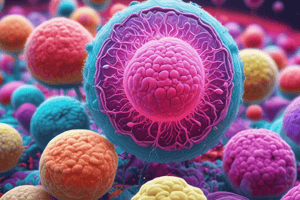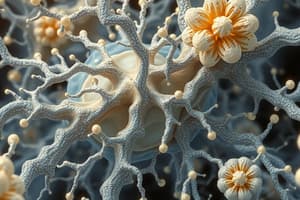Podcast
Questions and Answers
What is the major difference between prokaryotic and eukaryotic cells?
What is the major difference between prokaryotic and eukaryotic cells?
- Metabolic processes carried out by eukaryotic cells
- Presence of a defined nucleus in eukaryotic cells (correct)
- Size, with prokaryotic cells being larger
- Lack of cellular organelles in prokaryotic cells
Which type of cell ranges in size from micrometers to millimeters?
Which type of cell ranges in size from micrometers to millimeters?
- Bacterial cells
- Prokaryotic cells (correct)
- Eukaryotic cells
- Plant cells
What function is performed by both prokaryotic and eukaryotic cells?
What function is performed by both prokaryotic and eukaryotic cells?
- Cell division (correct)
- Photosynthesis
- Mitochondrial respiration
- Cell wall formation
Which type of cell lacks a defined nucleus and other membrane-bound organelles?
Which type of cell lacks a defined nucleus and other membrane-bound organelles?
What are tissues in multicellular organisms composed of?
What are tissues in multicellular organisms composed of?
Which tissue is responsible for absorbing nutrients, secreting fluids, and preventing invasion by foreign substances?
Which tissue is responsible for absorbing nutrients, secreting fluids, and preventing invasion by foreign substances?
What distinguishes eukaryotic cells from prokaryotic cells?
What distinguishes eukaryotic cells from prokaryotic cells?
What type of tissue enables communication between different parts of the body through electrical signals?
What type of tissue enables communication between different parts of the body through electrical signals?
Which tissue produces and secretes hormones or specific substances like digestive enzymes?
Which tissue produces and secretes hormones or specific substances like digestive enzymes?
What is the function of endocrine tissue in multicellular organisms?
What is the function of endocrine tissue in multicellular organisms?
Flashcards are hidden until you start studying
Study Notes
Biology: The Study of Life
The vast field of biology encompasses various aspects of life, from the fundamental units of life to diverse organisms and ecosystems. Two essential components of biology are the cell, which serves as the building block of all living beings, and tissues, which are specialized groups of cells performing specific tasks within multicellular organisms. Let's dive deeper into these concepts and explore what makes them so integral to our understanding of life.
Cell: The Unit of Life
Cells, the basic unit of life, come in two varieties: prokaryotic and eukaryotic. Prokaryotes lack a nucleus and other membrane-bound organelles, while eukaryotes possess these structures. These units of life range in size from bacteria, which can measure micrometers, to large plant cells, reaching millimeters. Despite the differences between the two types of cells, both perform similar processes such as metabolism, growth, reproduction, response to stimuli, and maintenance of homeostasis.
Prokaryotic vs. Eukaryotic Cells
The major distinguishing feature between prokaryotic and eukaryotic cells lies in their internal membranes, specifically the presence of a defined nucleus surrounded by a nuclear envelope. Prokaryotic cells have simpler structures and tend to function autonomously, while eukaryotic cells collaborate within complex organisms, where division of labor occurs among specialized cells. Compared to prokaryotic cells, eukaryotic cells are larger and more structurally organized, housing multiple compartments, including mitochondria for energy production, chloroplasts for photosynthesis, and a Golgi apparatus for lipid and protein processing.
Tissues
Within multicellular organisms, tissues are the foundation for complex structures and functions. Tissues are specialized groups of cells that perform specific tasks, such as support, protection, digestion, secretion, and absorption. These specialized cells work together to ensure the proper functioning of the organism.
Common Types of Tissues
Several types of tissues exist, each with unique characteristics and functions. These include:
-
Epithelial tissue: This protective tissue forms the outer layer of the body and lines internal organs. It is responsible for various functions like absorbing nutrients, secreting fluids, and preventing invasion by foreign substances.
-
Connective tissue: This tissue provides support and connects various organs and body parts. It also plays a role in the production of blood vessels and storage of fat.
-
Muscle tissue: This tissue allows for movement and maintains posture. It is classified into three types: skeletal, smooth, and cardiac muscle.
-
Nervous tissue: This tissue enables communication between different parts of the body through electrical signals, facilitating responses to internal and external stimuli.
-
Glandular tissue: This tissue produces and secretes hormones or specific substances, such as digestive enzymes in the pancreas or insulin in the pancreas.
-
Endocrine tissue: This tissue secretes hormones directly into the bloodstream, regulating various physiological processes.
Tissue Organization in Multicellular Organisms
Tissues work together to form organs, which are specialized groups of cells performing specific functions. These organs, in turn, form organ systems, which are collections of organs working together to maintain the overall health and proper functioning of the organism. An example of an organ system is the respiratory system, which includes the lungs, windpipe, and diaphragm, working together to facilitate gas exchange between the body and the environment.
In conclusion, cells and tissues are fundamental components of biology, providing the foundation for understanding life at various levels. Cells, as the basic units of life, come in two main types: prokaryotic and eukaryotic, each with distinct characteristics. Tissues, specialized groups of cells, perform specific tasks within multicellular organisms, allowing for complex structures and functions. Together, these concepts provide the essential groundwork for exploring the vast and diverse field of biology.
Studying That Suits You
Use AI to generate personalized quizzes and flashcards to suit your learning preferences.





